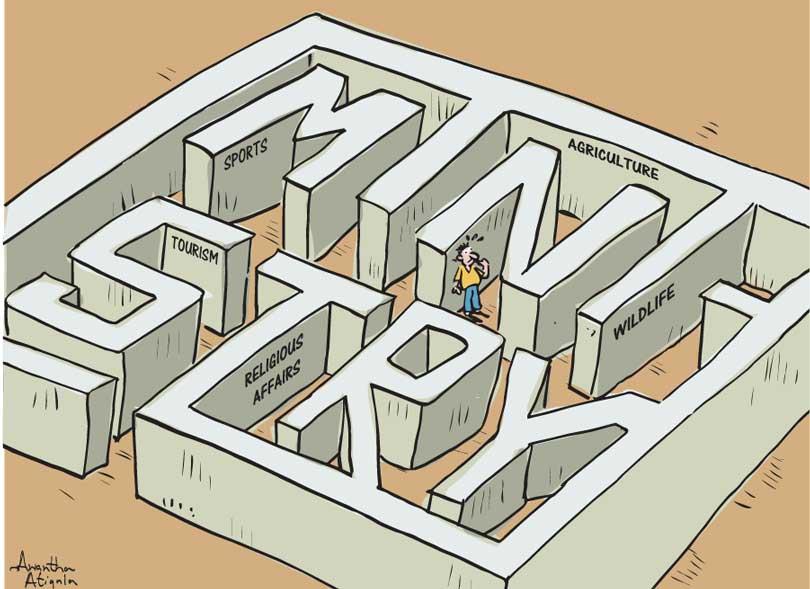Reply To:
Name - Reply Comment

This means that from 2010-2023, 111 gazettes have been published to change either the duties and functions assigned to ministries, the institutions that are assigned to those ministries or the laws that these ministries are supposed to implement
It would be an absolute surprise for someone walking into a local ministry to find everything crystal clear. Rather it could be just the opposite with the operation all over the place. Sri Lanka’s system of government has a history of assigning unrelated subjects to a single ministry, thereby including multiple departments and institutions under one roof. The latest blueprint document for rational government by Verité Research reveals that the compositions of ministries had undergone changes 111 times between 2010 and 2023.
This means that from 2010-2023, 111 gazettes have been published to change either the duties and functions assigned to ministries, the institutions that are assigned to those ministries or the laws that these ministries are supposed to implement. “Each gazette also doesn’t mean one ministry. Per gazette, there may be multiple ministries that undergo these changes. So almost at a frequency of once per month since 2010, ministries have been changed at least 111 times as and when a gazette is being published,” Verité Research, Executive Director Dr. Nishan De Mel said.
As such from 2010 to 2015, the compositions of ministries have changed nine times, whereas between 2015-2019 this has occurred 28 times, between 2019-2022 the compositions of ministries have changed 53 times and from 2022-2023 it had occurred 21 times. Dr. De Mel further said that what could be identified from these changes is that the current system of government lacks rationale since there is no clear methodology by which these changes are being made, by which ministries are assigned respective duties, functions and institutions and the laws that should be implemented.
Primary issues
The document also identifies three primary issues including fragmentation, misalignment and the third being the product of the first two issues which results in ministries changing. “In terms of fragmentation, ministry purviews are always fragmented which means that subjects that should be assigned under a single ministry are often split into multiple, separate ministries. For example, agriculture is often broken down into multiple ministries on the level of subjects such as irrigation, livestock, fertilizer and agriculture. These are not unrelated areas. Coordination is necessary between these sectors if you wish to make an effective implementation of whatever agricultural policies necessary. But when these ministries are separated, ineffective coordination increases time to implement policies, costs a lot of money to the public and there is also the lack of accountability,” he explained.
The research further indicates how previous governments have mastered the art of assigning unrelated subject areas under a single ministry. Dr. De Mel highlighted a few examples as follows; “From September 2015 there had been a Ministry of Postal Services as well as Muslim Religious Affairs. Then in June 2019, there was a Ministry of Tourism Development, Wildlife and Christian Religious Affairs. June 2019 also saw the Ministry for Telecommunications, Foreign Employment and Sports. The more recent example is that in February this year, a Ministry of Tourism and Lands was set up. These are unrelated subjects and there is no way that they can be housed under a single ministry. But as a result of these factors ministries always have institutions housed under them that are ever-changing. For instance, the Department of Immigration and Emigration has changed ownership ten times since 2015. It has been under the Ministry of Internal Affairs, Wayamba Development and Cultural Affairs, and so on. In April 2020, the Department of Immigration and Emigration was under the Ministry of Mahaweli, Agriculture, Irrigation and Rural Development. This shows the lack of clarity around which institutions are shuffled between the ministries that they are housed in. Another example is with regards to the National Lotteries Board which changed ownership eight times during this period. At one time it was housed under the Ministry of Foreign Affairs in September 2015,” he added.
Creating a rational form of government
The primary objective of this blueprint document is to ensure that a more rational form of government is being developed in Sri Lanka. The research conducted by Verité Research and existing work conducted by governments indicate that forming a rational form of government is possible. For example, expert recommendations issued by the Administrative Reforms Commission (ARC) that took place in 1988 under President J. R Jayewardene identified particular weaknesses of the present system by which Cabinets are formed. “The ARC recommended that this form of government be trimmed down to 16 ministries. Our proposal suggests that we can do with 15 ministries instead, broken down into separate subject areas. But we do not necessarily suggest that there’s one perfect method by which Cabinet ministries can be formulated and assigned. We have reduced as much as possible, issues of fragmentation, misalignment and how institutions can be housed under single ministries. This is a way by which governments can have a foundation to make government structure more rational. We believe that conversations could arise as to how ministries could be created - it can be 15, 16 or 20 ministries but the reduction of ministries, making government more rational, efficient, effective and being of greater utility to the country is ultimately the purpose behind this blueprint document. This blueprint document could be used to reduce the size of ministries to bring about a more rational, effective and efficient public service,” Dr. De Mel noted.
Verité Research further recommends the appointment of three ministers (Cabinet, Deputy and State) for each ministry with a total of 45 ministers and amends the Constitution accordingly. Include the number and outline of ministries in the Constitution. While the Constitution of Sri Lanka limits the number of ministers, it doesn’t specify the maximum number of ministries or their areas of responsibility, exposing ministries to frequent change.